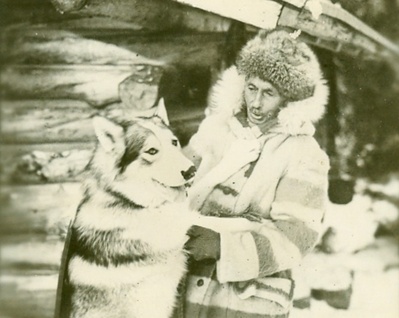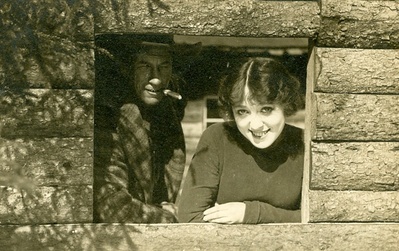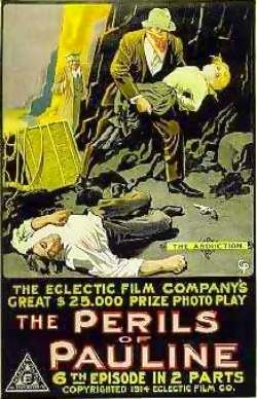 Perils of Pauline Saranac Lake was used as a film location in the early years of the silent film era. There was a small studio complex on Edgewood Road, established about 1910 by William F. Cooper, known as Caribou Bill. Location shots were also done in the village, on Lower Saranac Lake, Whiteface Mountain and at Franklin Falls.
Perils of Pauline Saranac Lake was used as a film location in the early years of the silent film era. There was a small studio complex on Edgewood Road, established about 1910 by William F. Cooper, known as Caribou Bill. Location shots were also done in the village, on Lower Saranac Lake, Whiteface Mountain and at Franklin Falls.
Saranac Lake's role in the movies did not end with the silent era— in 1982, Fred G. Sullivan filmed Cold River in Paul Smiths, Saranac Lake and other Adirondack locales, and in 1990, King of New York was shot using Saranac Lake's streets to fill in for the big city to the south.
The following article was originally published in the Adirondack Daily Enterprise in February, 2008. The article, written by Amy Catania and Mary Hotaling, was one of a series of articles written for the Winter Carnival theme, "Hooray for Hollywood".
Saranac Lake: The First Hollywood
For the third year, Historic Saranac Lake is providing a series of articles which relate Saranac Lake history to the theme of Winter Carnival; this year it's "Hooray for Hollywood!" Of course, "Hollywood" means "the movies," and Saranac Lake has a long history and some surprising connections with the movies, and the actors and actresses who have starred in them. Almost 100 years ago, before the movie industry moved to California, our lake and mountain setting and winter weather provided an ideal location in which to film tales of the Yukon. Later, summer theatres — in tents and on more permanent stages — provided entertainment for the audiences and experience for up-and-coming actors. William Morris, whose actor's agency still operates, first came to Saranac Lake to cure. A bevy of stars came to relax at his Camp Intermission, as well as to entertain patients at Will Rogers Hospital and raise money for local charities through shows at the Pontiac Theatre. These are just a few of the ways that Saranac Lake has always said "Hooray for Hollywood!"
Years before Hollywood meant movies, Saranac Lake was a hot spot for motion picture production. A visitor to the village in 1915 would easily have spotted famous stars of some of the biggest silent films of the day and may have had the chance to watch the production of an outdoor adventure film. Local young ladies enjoyed waiting on stars at John Morgan’s St. Regis Hotel, and local children and adults took part as extras and stunt doubles in many of the films. It was an exciting time in Saranac Lake. The little city in the Adirondacks, already transformed by TB patients and their families from around the world, now bustled with movie stars too.
In the days of silent pictures, the movie industry had not yet moved west. The heart of the industry was New York City and New Jersey. The fad at the time was to portray the gold rush era in the Klondike and Yukon Territories. Saranac Lake was the perfect location to produce these snowy outdoor adventure movies.
One fascinating character arrived in town from Alaska by dogsled and promptly ushered the movies to Saranac Lake. William F. Cooper (also known as Caribou Bill) delivered mail by dogsled in Alaska for twenty years, and lived with the Eskimos for part of that time. In Alaska, he was a friend of Jack London, author of The Call of the Wild and White Fang. In 1910, Caribou Bill drove a dogsled from Alaska to the East Coast. This tall rugged character draped in furs and surrounded by huskies grabbed the attention of the motion picture companies.
Caribou Bill landed in Saranac Lake, and with the backing of the film industry, built an outdoor film set on Edgewood Road, right next to where the high school stands today. A replica of a Klondike gold rush camp, the set served as the backdrop for The Shooting of Dan McGrew, When a Man Sees Red, and The Sin Woman. Nearby Lower Saranac was the setting for dramatic dogsled races across the ice.
Caribou Bill worked with movie stars such as Pearl White, Norma Talmadge, Clara Young, Harold Lockwood, Edmund Breese and the Farnum Brothers in his adventure films. According to Bill McLaughlin, the silent film goddess, Mary Miles Minter, stayed at the St. Regis Hotel with different film companies from 1912 through the mid 1920s. One young woman with local ties, Doris Kenyon, became a silent film star in her own right. Doris was the sister of Raymond Kenyon of Ausable Forks, and she frequently visited the area. Doris sang at the Metropolitan Opera and starred in many silent films. In 1924 she starred with Rudolph Valentino in "Monsieur Beaucaire."
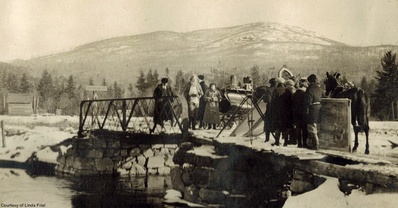 Norma Talmadge, as Princess Marie Pavlovna and Marc McDermott as Vasili Lazoff in The New Moon", in Saranac Lake, 1919.
Norma Talmadge, as Princess Marie Pavlovna and Marc McDermott as Vasili Lazoff in The New Moon", in Saranac Lake, 1919.
Historic Saranac Lake.
Saranac Lake locals, such as Fred Baily, Clint McDougal, Claud Lamy and Walter Kelly got into the action as extras, stunt doubles, and set designers. Saranac Lake’s own handsome police officer and gifted horseman, Walter Weir, brought his talents to many of the films. Ralph Kelly, a young boy growing up near Peck's Corners remembers being invited to ride in a sleigh with his dog by one of the glamorous Talmadge sisters.
Old timers will remember tales of the more dramatic stunts for these silent films. Many have heard the story of Harry Duso’s horse jump into the lake. Dressed as a woman (since he was serving as a stunt double for the female lead,) Duso jumped his horse off of a high bluff over the lower lake. 1Bill McLaughlin writes in a 1976 Enterprise article of one lucky waitress at the St. Regis who was filmed “fleeing from a villain across Moody Pond with this ice cut so that she would fall through.”
 A dog sled on Lower Saranac Lake, Dewey Mountain in the background.
A dog sled on Lower Saranac Lake, Dewey Mountain in the background.
Photograph courtesy of Terry Harbin, Ithaca Made MoviesSometimes the interests of the movie makers clashed with those of local residents. In a 1969 Enterprise article, Bill McLaughlin tells the tale of one silent film production that almost went up in smoke. The summer of 1917 was a dry one, and by October the woods were a wildfire waiting to happen. Against the strong protests of the local fire department, Caribou Bill’s director Graham Cohen insisted on shooting a scene on a particularly windy day, with a strong breeze coming off of Lower Saranac. The scene involved a campfire, which almost inevitably sparked a fire that burned seven acres. The fire alarm rang in the village, summoning thirty disgruntled firemen to put it out.
Silent film production cooled with the advent of World War I, and Saranac Lake began to lose its place as a capital of the movie industry Through the twenties, however, film crews continued to visit the north country to set dramatic footage in scenic spots. In 1926, the entire cast of the movie “Tin Gods” came to the Ausable Chasm to shoot an adventure scene, and they spent a day in Saranac Lake.
In 1919 Caribou Bill left Saranac Lake for Plattsburgh and opened a studio there. But already the industry had begun its move to Hollywood and his studio soon failed. The movie studios no longer wanted to make Yukon adventures. The new rage was war films, and then came the westerns.
Saranac Lake’s time as the first Hollywood had come to a close. Although the village would never again enjoy the limelight as the center stage for movie production, it would go on to host many a famous Hollywood star coming for the fresh air cure.
Oregonian, February 20, 1916 2
Screen Gossip
Harry Handworth and a company of 20 players are working at Saranac Lake on "The Question," in which Marguerite Leslie plays the leading role.
 Caribou Bill's arctic village set near Ampersand Bay.
Caribou Bill's arctic village set near Ampersand Bay.
Photograph courtesy of Terry Harbin, Ithaca Made MoviesOregonian, April 16, 1916
Screen Gossip
Owing to the death of one of the actors playing in "The Woman of It," that production will be released early in May instead of the latter part of April, as originally intended. The actor, a comparative unknown, became crazed while a great fire scene was being made at Saranac Lake. The scene represented a camp in the heart of the snow country.
A huge bonfire was burning, crowds of supposed natives of the Northland were actively passing around the lighted zone, when suddenly, with a terrible shriek, the crazed man ran right into the fire and before he could be gotten out was so severely burned that he died hours later. The members of the cast were so shocked that they returned to New York and were granted a few days' rest. Carlyle Blackwell, Ethel Clayton and Paul McAllister were among those who witnessed the tragedy.
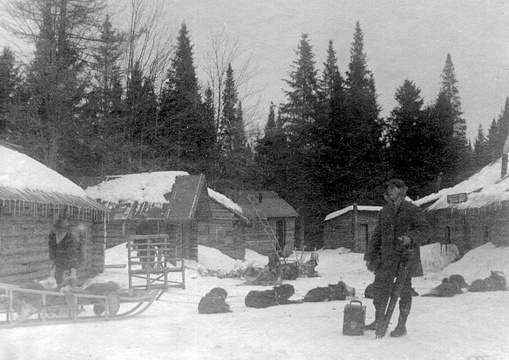 Caribou Bill's arctic village set. Cameraman Levi Bacon is getting ready for filming.
Caribou Bill's arctic village set. Cameraman Levi Bacon is getting ready for filming.
While the dogs and sled are being prepared for another movie scene from the 1917 film "The Great White Trail" filmed by The Wharton Studios from Ithaca, New York.
Photograph courtesy of Terry Harbin, Ithaca Made MoviesMalone Farmer, March 28, 1917
Saranac Lake has been frequently visited by movie picture companies this winter. They use that section to put Alaskan and Alpine scenes on the screen. The other day a company of 40 movie stars camped down at the St. Regis Hotel to make pictures. In a "gold seekers" hunt in a scenario entitled "The Great White Trail" developed at Saranac Lake the past week, over 100 Saranac Lake woodsmen took part and two Saranac Lake men were impressed into service as leading characters, D. T. Buckley taking the part of a general bully and rowdy of the North Country, and Henry Duffin playing the part of a U. S. Marshal. Buckley tries to shoot up a mining saloon and the marshal tries to arrest him, but he escapes. Doris Kenyon, the charming sister of Assemblyman Kenyon, of Essex county, is the heroine of the play and was in Saranac Lake when the film of another scenario shown in Malone a couple of weeks ago, in which she was the heroine, was shown in Saranac Lake. As a special favor she appeared on the stage there In the Pontiac Theatre at the close of the picture play. She was formerly on the legitimate stage, but has since become one of the leading favorites of the screen. For the staging of Arctic scenes Saranac Lake is unsurpassed.
Adirondack Record, January 11, 1918
WILL FAKE SOME NORTHWEST SCENES NEAR SARANAC LAKE
One of the greatest motion picture dramas of the Northwest ever produced will likely be filmed near Saranac Lake within the next few weeks. Negotiations have been practically completed to begin work on a Fox production in which William Farnum, the celebrated star, will have the leading role.
Lake Placid News, June 2, 1922
MOVIE STARS COMING TO SARANAC LAKE
Under the direction of Herbert Brennon, famous director, William Farnum, Fox film star, and a company of seventeen members will arrive in Saranac Lake on June 10 to shoot the exterior scenes for William Farnum's new picture.
George Cline, business manager of the Fox company, has advised the Saranac Lake chamber of commerce that work on the interior scenes of the picture has started. Five interior sets have been built from still pictures taken at a lumber camp near Saranac Lake which will be used when the company arrives there for work.
According to the information forwarded, the company will remain in Saranac Lake about three weeks.
Chicago Defender (African-American newspaper) September 29, 1923, p. 1. 3
[Mme. Pauline Dempsey, black actress, died recently in New York City] "after a protracted illness, the result of injuries received in December. Mme. Dempsey had been employed by the Whitman Bennett studios at that time and was one of the characters in a picture that was being filmed for the movies at Saranac Lake. A coasting scene was being made, and in the downward plunge of the toboggan it struck a stump which upset the entire party and from which the madam sustained a broken hip and leg and suffered internal injuries."
From a website selling a poster from this movie:
The silent film drama "The New Moon" was released in 1919 by Select Pictures Corporation and stars the renowned dramatic actress, Norma Talmadge. The story centers on a Russian princess who fights a corrupt dictator who forces all women between the ages of seventeen and thirty-two to register and become property of the state. The stone lithograph artwork depicts a beautiful image of Princess Marie Pavlovna (Norma Talmadge) as she desperately tries to rescue an unconscious older woman from the Russian nobility during a dramatic moment from the film.
The New Moon; Select Pictures Corporation; 1919; dir: Chester Withey; cast: Norma Talmadge, Pedro de Cordoba, Charles K. Gerrard, Stuart Holmes, Marc McDermott, Ethel Kaye, Harry Sothern, Marguerite Clayton, Mathilde Brundage.
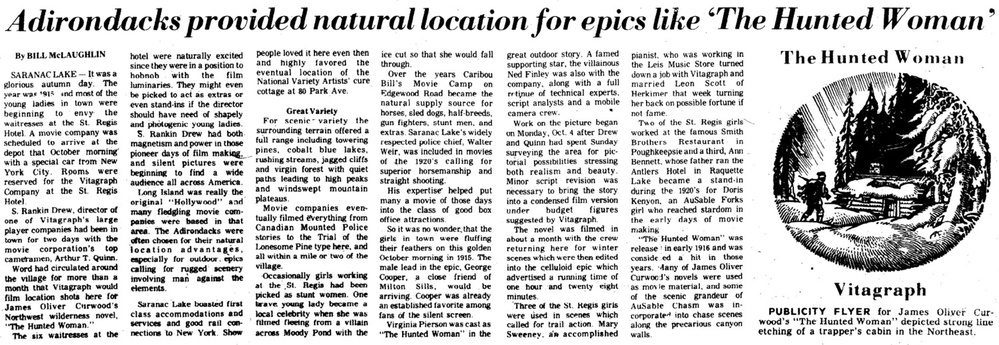 Adirondack Daily Enterprise, March 23, 1976. Courtesy of the Northern New York Library Network
Adirondack Daily Enterprise, March 23, 1976. Courtesy of the Northern New York Library Network
Films shot in the region include
-
The Call Of The Wild, 1908
-
The Great Mail Robbery, c. 1912
-
Lure Of The Yukon, 1914
-
Perils of Pauline 1914, Pearl White
-
Girl From Alaska, 1915
-
Hearts in Exile, 1915
-
The Sentimental Lady, 1915
-
The Wonderful Adventure, 1915
-
Harrigan's Gold, 1916
-
Blazing Love, 1916
-
The World and the Woman, 1916
-
Jury of Fate, 1917
-
Great White Trail, 1917
-
The Long Trail, 1917
-
When a Man Sees Red, 1917
-
The Sin Woman, 1917
-
Deluxe Annie, 1918
-
Go Get 'em Hutch, 1922
See also:
Sources
-
Taylor, Robert, Saranac: America's Magic Mountain, Boston: Houghton Mifflin, 1986, p. 146. 0-395-37905-9.
Comments
Footnotes
1. The bluff was on Bluff Island. While this dive is widely credited to Harry Duso, his son, Don has said that, while his father did jump from Bluff Island as a stunt person, he did not do so on horseback. Rather, local policeman Walt Weir appears to have been the jumper.
2. Thanks to Sally Svenson for this item and the one following.
3. Thanks to Sally Svenson for this item.
4. The money that was raised for the ailing Actors would have been for the National Variety Artists Lodge that later in 1936 would be renamed the Will Rogers Memorial Hospital.



